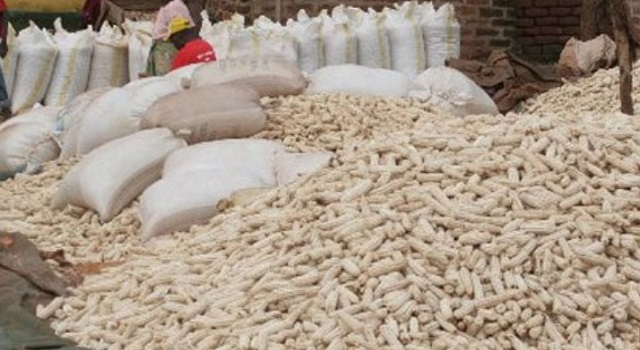
Why government needs to think beyond Shs100bn loan facility
Kampala, Uganda | JULIUS BUSINGE | The government recently made a policy announcement targeting maize farmers and traders.
It promised to provide Shs100bn as loan facility, through the Bank of Uganda’s Agriculture Credit Facility to maize traders to enable them buy the commodity at a fairly higher price compared with the market price.
This was in response to a 75% drop in the current maize grain price to Shs200 per kilogramme on the back of increased supplies coupled with increased production of other food crops – rice, sweet potatoes, cassava and bananas.
But the new policy intervention will not solve the maize price crisis, according to the economic experts and analysts familiar with this trade.
“Government’s move to inject money into stabilising maize prices was misguided,” Fred Muhumuza, an economist and lecturer at Makerere University told The Independent in an interview.
“The problems here are that the government does not know how much maize was there, whether or not traders didn’t have capital and that the trader will offer better prices to farmers because they secured government loan.”
Muhumuza says it is not true that traders will give farmers a higher price just because they have borrowed funds from government. In fact by the time the money reaches the trader, the season would have moved on, he adds.
He said maize traders normally have enough capital to go about their businesses and that it is during similar periods of falling prices that they reap huge profits.
He, however, says the current predicament would have been solved by the now collapsed cooperative societies.
“The cooperatives would have been a solution because it belongs to people,” he said adding, “It naturally offers them a fair price knowing that if they sell at a higher price, they will still pay a higher price when they want to purchase the commodity during shortage.”
However, Finance Minister, Matia Kasaija said the intervention was driven by circumstances insisting that government does not want to discourage farmers from growing maize which would result into food insecurity and importing of the commodity.
He said through BoU, commercial banks would disburse up to Shs5bn at 15% interest rate to a single eligible trader in a period of seven working days upon receiving the loan application.
He said the maximum credit an individual will be able to secure as loan is Shs20bn and processing of such loan would be done within 20 working days from the date of application.
He said traders with requisite storage, drying and cleaning facilities will have to store it for a period of six months when the price is expected to stabilise and go up.
This comes at the time Kenya, which imports over three million tons of maize a year from the country, has not been active for most parts of this year, according to Julius Mukasa, a coordinator of maize exporters.
He also revealed that Rwanda has resorted to importing maize flour from Tanzania instead of Uganda.
Available statistics from Grain Council of Uganda (TGCU) shows that Uganda produces about 5 million tons of maize grain, of which one million is consumed locally and the balance is kept and more traded across the region.
Ezra Munyambonera, the head of Macroeconomics Department at the Economic Policy Research Centre, Makerere University, who was involved in advising government on this loan policy direction, told The Independent that price stabilisation is a response for every country.
“If farmers stop growing maize because of falling prices, that can cause food insecurity and affect the economy,” he said.
He said such intervention should always be there backed up by policy structures and mechanisms.
He was optimistic that maize stored would be bought in the region in the coming months should countries in the region record shortage in harvests.
Going forward, Munyambonera said more interventions should focus on supporting farmers and traders by investing in good and new technology for value addition and storage, targeting internal and external markets.
“Government should wake up and help the farmers,” he said.
Traders say money is not a problem
Chris Kaijuka, a board member of the TGCU, which has a total of 120 members (with around 75 active ones), said the members are ready to take up the facility for as long as the terms and conditions are flexible.
He said members have enough capital to purchase maize way above the Shs100bn loan facility that government plans to offer.
“The money is not a favor to us; some members will go for it, others will not,” he said, adding “Only 35 members had expressed interest to borrow this money by August 11.”
He said the government loan could be easy to access given that the would-be purchased grain stock would be used as security instead of other assets.
Being one of the most consumed crops by households, institutions like schools, relief agencies across Uganda and the region, Kaijuka is optimistic that buying and storing of the crop makes business sense.
Speaking on the way forward, Kaijuka and the Private Sector Foundation Uganda Executive Director, Gideon Badagawa said there should be a permanent price stabilisation fund to deal with future price fluctuations, strengthening market ties within the region and beyond so as to give confidence to farmers.
Similarly, Peter Frederick Wamboga–Mugirya, a director for communication and partnerships at the Science Foundation for Livelihoods and Development, a non-governmental organization working with farmers to improve their production, said it is time to emulate Kenya.
“We need to have cereals board like it is in Kenya such that when maize prices fall on the market, the government comes in to purchase the surplus at a fair price,” he said, adding that it is too early to leave every business in the hands of the young private sector.
 The Independent Uganda: You get the Truth we Pay the Price
The Independent Uganda: You get the Truth we Pay the Price



